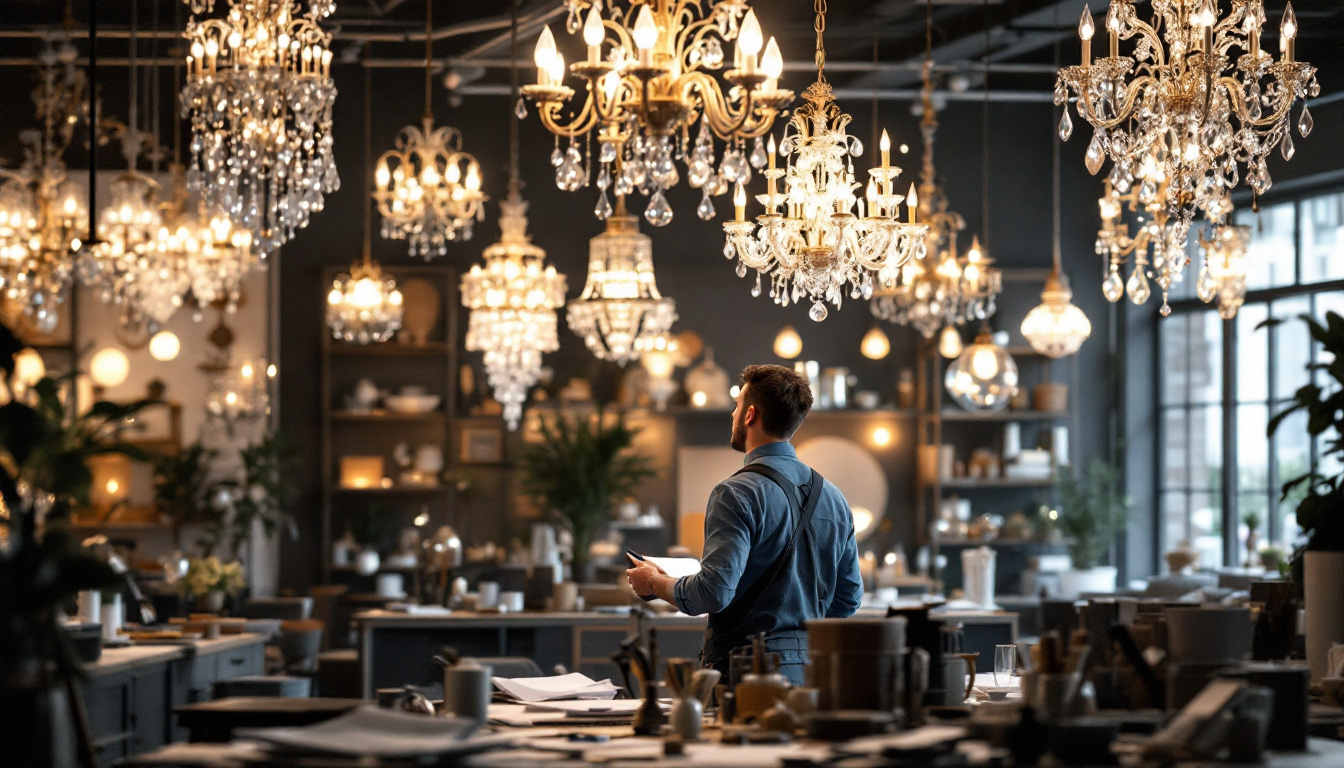
Lighting contractors play a crucial role in transforming spaces through the effective use of light. Among the various lighting options available, chandeliers stand out as a timeless choice that adds elegance and sophistication to any environment. Whether it’s for residential, commercial, or hospitality projects, understanding the essentials of chandeliers can significantly enhance a contractor’s ability to meet client needs and preferences. This article delves into the key considerations lighting contractors should keep in mind when working with chandeliers, as well as the essentials that a chandelier store should offer.
Chandeliers come in a variety of styles, materials, and designs, each serving different purposes and aesthetics. For lighting contractors, it is essential to understand these variations to recommend the best options to clients.
Traditional chandeliers are characterized by their ornate designs, often featuring intricate metalwork and crystal embellishments. These fixtures are ideal for classic or formal settings, such as dining rooms or grand entryways. When selecting traditional chandeliers, contractors should consider the scale of the space and the height of the ceiling to ensure the fixture complements the room. Additionally, the choice of bulbs can influence the ambiance; warm-toned bulbs can enhance the elegance of crystal elements, creating a soft glow that elevates the overall decor.
In contrast, modern chandeliers embrace minimalist designs, often utilizing sleek lines and contemporary materials like glass or metal. These fixtures are perfect for modern homes and commercial spaces that favor a clean, uncluttered look. Lighting contractors should be aware of the latest trends in modern chandelier designs, as client preferences can shift rapidly in this area. Moreover, many modern chandeliers incorporate energy-efficient LED technology, which not only reduces electricity costs but also allows for innovative designs that can be both functional and artistic, making them a popular choice among eco-conscious clients.
Rustic chandeliers often incorporate natural materials such as wood and wrought iron, making them suitable for cabins, farmhouse-style homes, or outdoor spaces. Vintage chandeliers, on the other hand, evoke nostalgia and charm, often featuring antique finishes and unique designs. Understanding these styles allows contractors to cater to a broader range of client tastes. Furthermore, the integration of reclaimed materials in rustic designs can enhance sustainability, appealing to clients who prioritize eco-friendly choices. Vintage chandeliers can also be found in various styles, from Art Deco to Mid-Century Modern, giving contractors the opportunity to educate clients about the historical significance and craftsmanship behind each piece, thereby enriching their purchasing experience.
Selecting the right chandelier involves more than just choosing a style. Lighting contractors must consider several factors to ensure that the chosen fixture meets both aesthetic and functional requirements.
The scale of the chandelier in relation to the room is paramount. A chandelier that is too large can overwhelm a space, while one that is too small may look insignificant. Contractors should measure the room dimensions and consider the ceiling height to determine the appropriate size. A general guideline is to add the room’s dimensions (in feet) and use that number to determine the diameter of the chandelier in inches. Additionally, the visual weight of the chandelier should complement the other elements in the room, such as furniture and decor. A well-proportioned chandelier can serve as a stunning focal point, drawing the eye upward and enhancing the overall design of the space.
Different spaces have varying lighting needs, and chandeliers can serve multiple purposes. For instance, a dining room chandelier should provide ample light for meals, while a chandelier in a hallway may serve more as a decorative element. Contractors should assess the intended use of the space and recommend chandeliers with appropriate wattage and bulb types to meet those needs. Furthermore, the color temperature of the bulbs can significantly affect the ambiance; warmer tones create a cozy atmosphere, while cooler tones can lend a more modern and vibrant feel. It’s also worth considering dimmable options, which allow for versatility in lighting levels, making it easy to transition from bright task lighting to a softer, more intimate glow for gatherings or special occasions.
Installation can vary significantly depending on the chandelier’s design and weight. Some chandeliers require professional installation due to their complexity, while others can be easily hung by the homeowner. Lighting contractors should be prepared to advise clients on installation requirements and may need to coordinate with electricians for more intricate designs. Additionally, the location of the chandelier is crucial; it should be hung at an appropriate height to avoid obstruction and ensure safety, particularly in high-traffic areas. Consideration should also be given to the type of ceiling, as sloped or vaulted ceilings may necessitate specialized mounting hardware or techniques to achieve the desired look and function. Overall, thorough planning during the selection and installation process can lead to a stunning and effective lighting solution that enhances the beauty of any space.
A well-stocked chandelier store is invaluable for lighting contractors, providing access to a wide range of products and resources. Here are some essential features that such a store should offer.
A chandelier store should carry a diverse selection of chandeliers, including various styles, sizes, and materials. This variety allows contractors to find the perfect fixture for any project, whether it’s a modern loft or a classic estate. Additionally, having access to different brands can provide options at various price points, catering to different client budgets. From elegant crystal designs that add a touch of luxury to minimalist fixtures that embrace simplicity, the right store will have something for every aesthetic. Furthermore, seasonal collections and limited editions can keep the inventory fresh and exciting, encouraging contractors to return for the latest trends.
Staff members at a chandelier store should possess extensive knowledge about the products they sell. This expertise is crucial for assisting lighting contractors in making informed decisions. Staff should be able to provide insights on the latest trends, installation tips, and maintenance advice, ensuring that contractors can offer the best recommendations to their clients. Additionally, knowledgeable staff can help educate contractors on energy-efficient lighting options and the benefits of LED technology, which is becoming increasingly popular. Their ability to answer technical questions and offer personalized service can make a significant difference in the contractor’s experience, fostering a sense of trust and reliability.
Many clients appreciate the opportunity to customize their chandeliers. A chandelier store that offers customization options, such as different finishes, colors, or sizes, can help lighting contractors meet specific client requests. This flexibility not only enhances client satisfaction but also allows contractors to showcase their design expertise. Moreover, some stores may provide a design consultation service, where contractors can collaborate with in-house designers to create unique, bespoke pieces that perfectly align with the client’s vision. This added layer of service can elevate the contractor’s offerings and set them apart in a competitive market, ultimately leading to more successful projects and satisfied customers.
Staying updated with the latest trends in chandelier design is essential for lighting contractors aiming to provide modern solutions to their clients. Trends can shift rapidly, influenced by factors such as interior design styles, technological advancements, and consumer preferences.
With the rise of smart home technology, integrating smart lighting into chandeliers has become increasingly popular. Smart chandeliers can be controlled via mobile apps or voice commands, allowing users to adjust brightness, color, and even set schedules. Lighting contractors should familiarize themselves with these products to offer clients innovative solutions that enhance convenience and energy efficiency.
As sustainability becomes a priority for many consumers, eco-friendly chandeliers are gaining traction. These fixtures often utilize energy-efficient LED bulbs and sustainable materials. Contractors should be prepared to discuss the benefits of eco-friendly options with clients, emphasizing long-term savings and environmental responsibility.
Another trend is the use of mixed materials in chandelier design. Combining elements like metal, glass, wood, and fabric can create unique, eye-catching fixtures that appeal to a wide range of tastes. Lighting contractors should encourage clients to explore these innovative designs, as they can add character and style to any space.
Dust and grime can accumulate on chandeliers, diminishing their appearance and light output. Regular cleaning is crucial, and contractors should recommend using a soft cloth or a feather duster to gently remove dust. For crystal chandeliers, a mixture of warm water and a few drops of mild dish soap can be used to clean the crystals without damaging them.
Over time, chandeliers can develop loose parts due to vibrations or changes in temperature. Lighting contractors should advise clients to periodically check for any loose crystals, bulbs, or mounting hardware. Addressing these issues promptly can prevent further damage and ensure the chandelier remains secure and functional.
As with any lighting fixture, bulbs in chandeliers will eventually need to be replaced. Contractors should educate clients on the types of bulbs compatible with their chandeliers and the importance of using the correct wattage. This not only ensures optimal performance but also helps avoid potential hazards.
Chandeliers are more than just decorative elements; they are integral to the overall ambiance and functionality of a space. For lighting contractors, understanding the various types of chandeliers, key selection criteria, and maintenance practices is essential for delivering exceptional service to clients. A well-stocked chandelier store that offers a diverse range of products, knowledgeable staff, and customization options can significantly enhance a contractor’s ability to meet client needs.
By staying informed about the latest trends and educating clients on proper care and maintenance, lighting contractors can establish themselves as trusted experts in the field. Ultimately, the right chandelier can elevate any space, making it a worthwhile investment for both contractors and their clients.
Ready to illuminate your projects with the finest chandeliers and lighting solutions? Look no further than LumenWholesale, where we provide lighting contractors with top-quality, spec-grade lighting products at the best wholesale prices. Our commitment to quality, affordability, and convenience ensures that you receive reliable, high-performance lighting without the inflated markups or hidden fees. Take advantage of our hassle-free bulk buying and free shipping to elevate your lighting projects. Experience the LumenWholesale difference today and bring unparalleled value to your clients.

Discover why outside electricity boxes are essential for lighting contractors, enhancing safety, efficiency, and compliance—boost your expertise today!.

Discover essential insights from lighting contractors on maximizing the efficiency and aesthetics of T5 LED lamps.

Discover the essential role of ballast lights in the lighting industry and why they are crucial for contractors.

Discover why Type C lamps are revolutionizing the lighting industry and why lighting contractors should prioritize them.